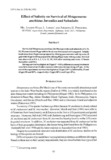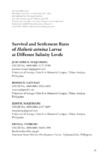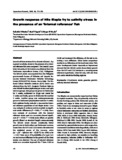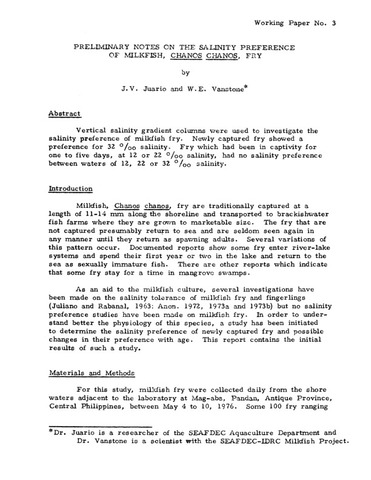Effect of salinity on survival of Metapenaeus anchistus juveniles and subadults
Share
Abstract
Survival of Metapenaeus anchistus (De Man) juveniles and subadults at 5, 15, 25, 35 (control) and 45 ppt salinity levels was determined and compared. Salinity levels lower than 35 ppt level were prepared by diluting pure seawater with tap water (OPPT) while 45 ppt level was prepared by diluting 85 ppt water with tap water. Survival was observed at 0.5, 1, 2, 3, 6, 12, 18, 24 h after stocking and every 12 hours thereafter until 96 h.
Shrimp survival was highest at 35 ppt (P<0.01); differences among treatments were first observed at 2 h after exposure with some shrimps dying at 5 ppt. At the end of the experiment, survival was highest at 35 ppt (100%), followed by 25 and 45 ppt (90 and 80%, respectively), 15 ppt (50%) and 5 ppt (0%).
Suggested Citation
Lebata, M. J. H. L., & Primavera, J. (1997). Effect of salinity on survival of Metapenaeus anchistus juveniles and subadults. UPV Journal of Natural Sciences , 2(2), 83-90. http://hdl.handle.net/10862/1589
Subject
Collections
- AQD Journal Articles [1248]
Related items
Showing items related by title, author, creator and subject.
-
Survival and settlement rates of Haliotis asinina larvae at different salinity levels
Maquirang, Jean Rose H.; Caturao, Romeo D.; Maquirang, Jessy H.; Pedroso, Fiona L. (IAMURE Multidisciplinary Research, 2013)The study was conducted to determine the optimum salinity levels (24 ppt, 28 ppt, 32 ppt, 36 ppt and 40 ppt) for the survival and settlement rates of H. asinina in a complete randomized design with three replicates each. ... -
Growth response of Nile tilapia fry to salinity stress in the presence of an ‘internal reference’ fish
Basiao, Zubaida U.; Eguia, Ruel V.; Doyle, Roger W. (Blackwell Publishing, 2005)Growth of three strains of Oreochromis niloticus L. fry exposed to salinity stress in the presence of an internal reference fish were compared. The Central Luzon State University (CLSU) strain was obtained from the Freshwater ... -
Preliminary notes on the salinity preference of milkfish, Chanos chanos, fry
Juario, Jesus V.; Vanstone, William E. (Aquaculture Department, Southeast Asian Fisheries Development Center, 1976)Vertical salinity gradient columns were used to investigate the salinity preference of milkfish fry. Newly captured fry showed a preference for 32‰ salinity. Fry which had been in captivity for one to five days, at 12 or ...




